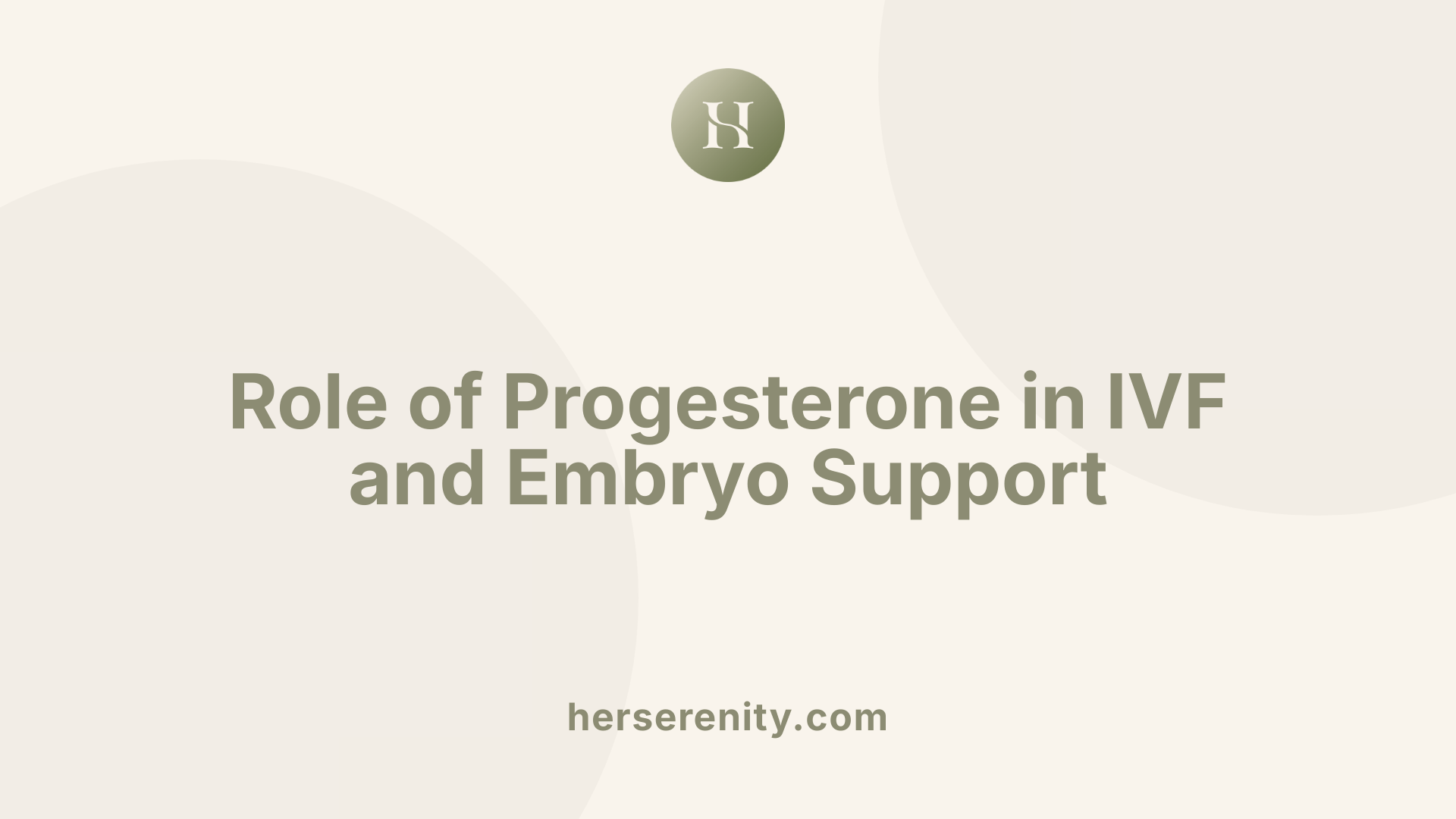Can low progesterone prevent pregnancy?
Understanding Progesterone's Crucial Role in Fertility and Pregnancy

The Hormonal Key to Conception and Pregnancy Maintenance
Progesterone, often called the 'pregnancy hormone,' plays an essential role in supporting menstruation, conception, and pregnancy. Its levels fluctuate naturally during the menstrual cycle and reach their peak in pregnancy. But what happens when progesterone levels are low? This article explores how low progesterone can affect a woman's ability to conceive, carry a pregnancy to term, and how it may be managed to support reproductive health.
What Is Progesterone and Why Is It Vital for Pregnancy?

What is progesterone and why is it important?
Progesterone is a hormone produced predominantly by the ovaries after ovulation, specifically by the corpus luteum. It plays a crucial role in the menstrual cycle and pregnancy by preparing the uterine lining, or endometrium, to support a fertilized egg. This preparation is essential for enabling successful implantation.
Role of progesterone in the menstrual cycle and pregnancy
During the menstrual cycle, progesterone levels peak in the luteal phase, the period right after ovulation. This hormone thickens the uterine lining, making it receptive to an embryo. If pregnancy occurs, progesterone production continues to increase, supporting the uterine environment necessary for fetal development.
Progesterone production after ovulation
After an egg is released, the corpus luteum—a structure formed from the follicle—produces progesterone. This surge ensures the endometrium becomes sufficiently thick to anchor an embryo. If pregnancy does not happen, progesterone levels fall, leading to menstruation.
Supporting pregnancy and preventing preterm labor
Once pregnancy begins, progesterone helps sustain the uterine lining and prevents contractions, thus reducing the risk of preterm labor. It also promotes breast development to prepare for breastfeeding. Around 8 to 10 weeks into pregnancy, the placenta takes over progesterone production to maintain the pregnancy.
Understanding progesterone's vital role helps clarify why maintaining adequate levels is essential for fertility and a healthy pregnancy journey.
How Low Progesterone Levels Affect Fertility and Pregnancy Outcomes

Impact on implantation and luteal phase defect
Low progesterone levels can critically impair the implantation process by preventing the uterine lining from thickening sufficiently to support an embryo. This issue, known as luteal phase defect, disrupts the period after ovulation—called the luteal phase—which is crucial for pregnancy initiation. A progesterone deficiency during this phase often results in a luteal phase lasting less than 11 days and can lead to implantation failure.
Connection to irregular periods and difficulty conceiving
Progesterone not only plays a role in maintaining pregnancy but also regulates menstrual cycle regularity. Women with low progesterone may experience irregular or short menstrual cycles, spotting before periods, and a shortened luteal phase. These irregularities hinder conception by disrupting the timing and environment necessary for fertilization and embryo implantation.
Increased risks of miscarriage, ectopic pregnancy, and preterm labor
Low progesterone is linked to an increased risk of serious pregnancy complications. Insufficient levels are associated with early miscarriage, ectopic pregnancies, and preterm labor due to the hormone's key role in sustaining pregnancy. Pregnancies with low progesterone often have smaller gestational sacs relative to gestational age and face higher miscarriage rates even when initially viable.
Symptoms and clinical implications of low progesterone
Common symptoms reflecting low progesterone include mood swings, spotting, abdominal pain during pregnancy, vaginal dryness, breast tenderness, and headaches. Women experiencing these symptoms, especially when trying to conceive or during early pregnancy, should consult healthcare providers for progesterone testing and potential supplementation. Monitoring and managing progesterone levels may improve pregnancy outcomes and reduce the risk of pregnancy loss.
Can low progesterone prevent pregnancy?
Yes, low progesterone can interfere with a woman's ability to conceive and maintain pregnancy. Insufficient progesterone may prevent the uterine lining from thickening adequately, leading to implantation failure, a condition sometimes called luteal phase defect. This hormone deficiency may also cause a shortened luteal phase and irregular menstrual cycles. Low progesterone is associated with higher risks of miscarriage, ectopic pregnancy, spotting, abdominal pain, and mood changes. Therefore, progesterone is essential for sustaining early pregnancy and reducing associated complications.
| Aspect | Effect of Low Progesterone | Clinical Notes |
|---|---|---|
| Implantation | Poor uterine lining development, implantation failure | Luteal phase defect diagnosis requires hormone level and cycle length monitoring |
| Menstrual Cycle | Irregular or short cycles, spotting | Affects fertility by disrupting ovulation timing |
| Pregnancy Risk | Increased miscarriage, ectopic pregnancy, preterm labor | Early detection through hormone testing can guide timely intervention |
| Symptoms | Mood swings, vaginal dryness, abdominal pain | Patients presenting symptoms should be evaluated for hormonal imbalance |
| Fertility Impact | Reduced conception rates, difficulties maintaining pregnancy | Progesterone supplementation can improve outcomes |
Common Causes and Risk Factors for Low Progesterone Levels

What causes low progesterone levels?
Low progesterone can stem from a variety of health and lifestyle factors affecting hormone production.
Anovulation and PCOS
Anovulation, where the ovary fails to release an egg during the menstrual cycle, is a primary cause of low progesterone because this hormone is produced after ovulation. Polycystic ovary syndrome (PCOS), a frequent hormonal disorder among women, often leads to irregular or absent ovulation, directly impacting progesterone levels.
Thyroid disorders and hyperprolactinemia
Conditions like hypothyroidism (underactive thyroid) and hyperprolactinemia (excess prolactin hormone) disrupt the hormonal balance and can reduce progesterone production, causing irregular menstrual cycles and fertility challenges.
Chronic stress and lifestyle influences
High stress levels trigger hormonal imbalances that inhibit ovulation and reduce progesterone. Similarly, extreme exercise, stringent dieting, and abnormal body weight — either very low or obesity — compromise hormonal health resulting in low progesterone.
Age-related hormonal decline and perimenopause
As women approach perimenopause, the natural decline in ovarian function leads to decreased progesterone output. This hormonal shift may result in shorter or irregular luteal phases and difficulties sustaining pregnancy.
Impact of diet, extreme exercise, and body weight
Nutrition plays a vital role; diets lacking essential vitamins and minerals can affect hormone synthesis. Excessive physical activity or very low body fat reduces progesterone production, while obesity also alters hormone levels negatively.
Understanding these causes helps inform targeted approaches for management and improving reproductive health.
Diagnosing and Monitoring Low Progesterone: Tests and Indicators

How is low progesterone diagnosed?
Low progesterone diagnosis primarily relies on blood tests measuring serum progesterone levels, usually conducted about seven days after ovulation during the luteal phase. This timing is critical because progesterone peaks during this phase, reflecting the hormone's production by the corpus luteum.
Blood tests and timing relative to ovulation
Blood testing around the midpoint of the luteal phase provides an accurate assessment of progesterone production. Early morning samples are often preferred to minimize daily fluctuations. Lower-than-expected levels at this point may indicate luteal phase defect or insufficient progesterone support.
Use of home ovulation kits
Home ovulation predictor kits detect the surge of luteinizing hormone (LH) that precedes ovulation. While these kits don't measure progesterone directly, confirming ovulation indirectly supports expected subsequent progesterone production. Irregular or absent ovulation indicated by these kits can suggest potential progesterone deficiency.
Progesterone levels during pregnancy and luteal phase
Progesterone levels naturally rise after ovulation and are highest during pregnancy. Monitoring serum progesterone in early pregnancy aids in assessing uterine environment suitability and pregnancy viability. Persistently low progesterone levels in the first trimester have been associated with increased risk of miscarriage.
Sonographic markers associated with low progesterone
Ultrasound imaging can reveal a gestational sac smaller than expected for gestational age, a subtle indicator linked to low serum progesterone. This sonographic sign helps clinicians evaluate the risk of pregnancy complications and make informed decisions about intervention.
Role of serum progesterone in predicting pregnancy outcomes
Serum progesterone acts as a biomarker for pregnancy maintenance potential. Low values correlate with higher miscarriage rates, while adequate levels suggest better ongoing pregnancy chances. Assessing progesterone enables healthcare providers to tailor treatments such as progesterone supplementation to improve outcomes.
| Diagnostic Method | Purpose | Clinical Insight |
|---|---|---|
| Blood test (7 days post-ovulation) | Measures luteal phase progesterone level | Identifies luteal phase defect or low progesterone |
| Home ovulation kit | Detects LH surge indicating ovulation | Indirectly supports progesterone status |
| Ultrasound (gestational sac size) | Assesses fetal development | Smaller sacs may indicate low progesterone |
| Serum progesterone monitoring | Predicts pregnancy viability and outcomes | Guides treatment decisions and risk assessment |
Treatment Options for Low Progesterone to Support Fertility and Pregnancy
How is low progesterone treated during conception and pregnancy?
Managing low progesterone is essential for supporting fertility and maintaining a healthy pregnancy. Treatments primarily focus on supplementing progesterone to ensure the uterine lining is properly prepared for implantation and to support early gestation.
Progesterone supplementation forms and timing
Progesterone can be administered in several forms including vaginal creams, gels, suppositories, oral tablets, and injections. Typically, supplementation begins after ovulation or early in pregnancy and is most critical during the first trimester. This timing helps maintain the uterine lining and reduces risks such as miscarriage and preterm labor.
Ovulation-inducing medications and assisted reproductive techniques
Medications like Clomid or letrozole are often prescribed to induce ovulation in women with ovulatory issues. In assisted reproductive techniques such as IVF, progesterone supplementation is commonly necessary because fertility medications can suppress the body's own progesterone production. Adjustments in progesterone dosage or administration method may be made based on individual response and serum levels.
Natural lifestyle and dietary supports
Alongside medical treatments, natural approaches can help support progesterone levels. A healthy diet rich in vitamin C, zinc, magnesium, and B vitamins promotes hormone balance. Regular exercise, stress management, and adequate sleep also contribute positively to progesterone production and overall reproductive health.
Tailoring treatment to individual circumstances
Progesterone therapy is customized based on a woman's health status, fertility goals, and pregnancy risk factors. For some, supplementation may only be necessary in early pregnancy, while others, especially those with history of miscarriage or preterm labor, may require extended duration or higher doses.
Duration and goals of progesterone therapy during pregnancy
Typically, progesterone supplementation continues through the first trimester, supporting implantation and placental development. In cases at risk for preterm birth, treatment may extend up to 34–36 weeks gestation. The ultimate goal is to improve pregnancy maintenance and live birth outcomes while minimizing complications.
Progesterone’s Role in Assisted Reproductive Technologies and Pregnancy Outcomes

What is the significance of progesterone in IVF and assisted reproduction?
In assisted reproductive technologies such as in vitro fertilization (IVF) and embryo transfer, progesterone plays a vital role in supporting pregnancy. The fertility medications used in these treatments can suppress the body's natural production of progesterone, which is essential for preparing and maintaining the uterine lining for embryo implantation.
Importance of progesterone monitoring in IVF and embryo transfer
Monitoring luteal serum progesterone levels during the luteal phase and early pregnancy helps clinicians assess whether progesterone supplementation is adequate. In artificial cycles where the corpus luteum is absent, low serum progesterone levels are linked to reduced ongoing pregnancy and live birth rates, as well as a higher risk of miscarriage.
Influence of luteal progesterone levels on live birth rates
Studies indicate that low luteal progesterone correlates with lower live birth rates, particularly in cycles with one or few corpora lutea. Conversely, in stimulated cycles with multiple corpora lutea, higher late luteal-phase progesterone levels are associated with improved live birth outcomes.
Adjustments in supplementation based on serum levels
When progesterone levels are found to be insufficient, treatment modifications can include increasing the dosage or switching to different routes of administration, such as vaginal gels, suppositories, or injections. Individualized progesterone therapy based on serum monitoring has shown potential to enhance pregnancy success, although the optimal serum progesterone thresholds remain under investigation.
Current research and controversies on progesterone supplementation efficacy
While progesterone supplementation is widely used to prevent miscarriage and preterm birth in high-risk pregnancies, evidence regarding its effectiveness is mixed. Some studies show beneficial effects on pregnancy maintenance, whereas others report inconclusive results. Despite this, progesterone therapy remains a common practice due to its low risk profile.
Safety and benefits of progesterone therapy in preventing miscarriage
Progesterone treatment during the first trimester in women with a history of pregnancy loss may reduce miscarriage rates without negatively affecting fetal development. It has also been linked to a decreased risk of low birth weight and is generally considered safe for both mother and baby.
| Aspect | Description | Clinical Implication |
|---|---|---|
| Progesterone in ART | Essential for supporting implantation and early pregnancy; suppressed by fertility drugs | Necessitates supplementation and monitoring |
| Luteal progesterone monitoring | Helps tailor treatment; low levels linked to miscarriage and lower live birth rates | Guides dosage and administration adjustments |
| Supplementation forms | Vaginal gels, suppositories, injections, oral tablets | Choice tailored to patient needs and clinical setting |
| Efficacy | Mixed evidence on preventing miscarriage and preterm birth | Used routinely due to safety and potential benefits |
| Safety | Considered safe; may reduce miscarriage and low birth weight risk | Encourages continued usage in indicated cases |
Navigating Progesterone’s Impact on Pregnancy Success
Low progesterone plays a significant role in fertility challenges and pregnancy complications due to its essential function in preparing and maintaining the uterine environment. Recognizing symptoms, diagnosing effectively, and applying individualized treatment strategies—including supplementation and lifestyle modifications—can improve conception chances and pregnancy outcomes. Although research continues to explore optimal treatment protocols, progesterone supplementation remains a cornerstone therapy in reproductive medicine, particularly for women experiencing luteal phase defects, recurrent miscarriages, or undergoing ART procedures. Consulting healthcare providers early can ensure timely interventions to support healthy pregnancies.
References
- Low Progesterone: Causes, Symptoms, Tests & Treatment
- Low Progesterone - Causes of Infertility - Texas Fertility Center
- Common Symptoms of Low Progesterone | IVF Clinic
- Low Luteal Serum Progesterone Levels Are Associated ...
- Low Progesterone During Pregnancy
- Signs of Low Progesterone and Its Impact on Fertility
- The significance of low first trimester serum progesterone ...


































































































